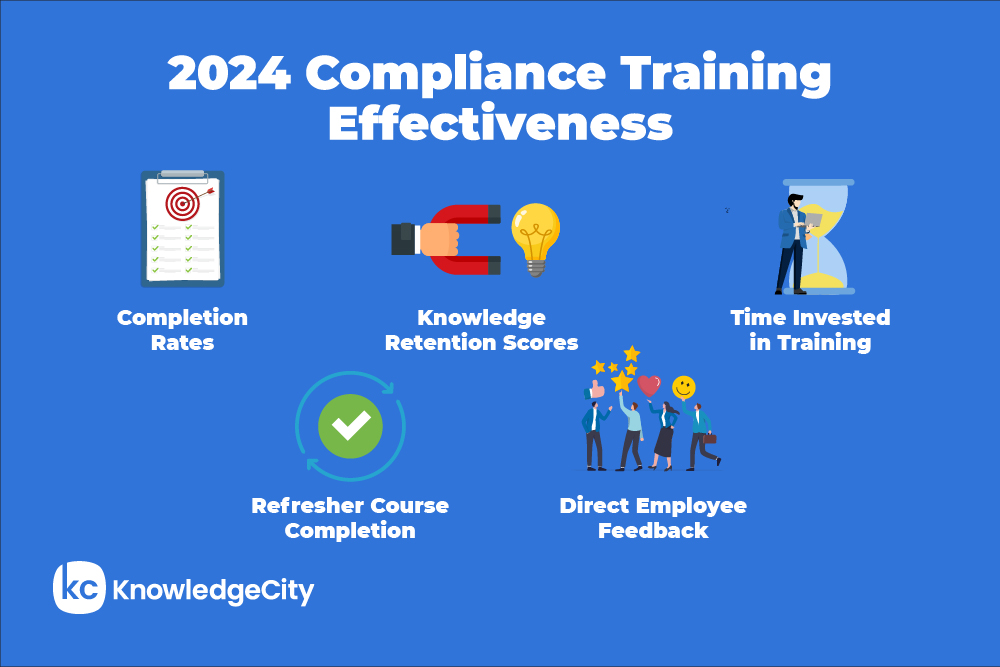Compliance training is a vital but often overlooked aspect of the modern workplace. In fact, Gallup finds that of employees who have participated in ethics and compliance training, only one in 10 strongly agree that they learned something that has changed how they do their work after participating in the program.
The purpose of compliance training is to ensure that employees understand and adhere to the laws, regulations, and policies that govern their industry. But it isn’t enough to simply provide compliance training—it’s also essential to track and measure the effectiveness of your training program to make sure it’s achieving its intended goals.

In this article, we’ll highlight the importance of tracking compliance training metrics and provide five key metrics to help you evaluate the success of your training program.
Why Track Compliance Training Metrics?
According to Gallup, fewer than one in four employees (23%) who participated in a compliance or ethics training session over the past 12 months would rate that training as “excellent.” You cannot improve your compliance training without properly assessing your current program and practices.
Tracking compliance training metrics allows you to evaluate the effectiveness of your program and make data-driven decisions to improve it. It also helps you identify any gaps in your training program, ensuring that your employees receive the necessary knowledge and skills to comply with regulations and policies.
By monitoring completion rates, assessment scores, time spent on training, refresher training completion rates, and employee feedback, companies can take steps to ensure that all employees are well-informed. Conducting surveys, regularly analyzing data, and adopting educational tools like a learning management system (LMS), are just a few of the most effective ways to track these metrics.
By tracking metrics, you can easily identify trends and patterns that might help you improve your training program. For example, if you notice a high failure rate on a particular compliance test, you can review the training material and make any necessary updates to improve employees’ understanding and retention.
Tracking metrics also helps with reporting your compliance during audits. By having the data on hand, you can easily prove to auditors that your employees have received the necessary training and are in compliance with regulations and policies.
Here are some other good reasons to track compliance training metrics:
-
- Improved Training Effectiveness: Metrics let you assess how well your compliance training programs are being received. By tracking completion rates, knowledge retention scores, and the application of learned skills, you can identify areas for improvement and ensure your training is actually working as intended.
-
- Targeted Interventions: Compliance metrics can help pinpoint specific weaknesses or knowledge gaps among certain employee groups. This allows for targeted interventions, such as refresher training or additional support for those who need it the most.
-
- Demonstrate Compliance: Robust compliance metrics can serve as evidence for regulatory bodies or auditors that your organization is taking a proactive approach to compliance. This can be important during inspections or investigations.
-
- Identify Trends and Risks: Tracking metrics over time can help identify emerging trends or areas of increased risk within your organization. This enables you to take proactive steps to address any potential issues before they snowball into serious problems.
-
- Optimize Training Resources: Metrics can help you identify areas where you might be wasting your training resources. For example, if a particular training module scores consistently low for engagement or knowledge retention, it might be more practical to revise it or replace it entirely.
-
- Boost ROI Justification: By demonstrating the positive impacts of compliance training on areas like reduced incidents or improved risk management, metrics can help strengthen the case for continued investment in training programs.
Five Key Compliance Training Metrics To Track
Now that we’ve discussed the importance of tracking compliance training metrics, let’s discuss the five key metrics that you should be monitoring:
-
- Completion Rates: The first and most basic metric to track your compliance training completion rate. This measures the percentage of employees who have completed the required training within the allotted time.
A high completion rate shows your employees are taking their training seriously and are committed to compliance. On the other hand, a low completion rate may indicate that your training program needs improvement, or that employees are not prioritizing their compliance training.
- Completion Rates: The first and most basic metric to track your compliance training completion rate. This measures the percentage of employees who have completed the required training within the allotted time.
-
- Assessment Scores: Assessment scores measure how well employees are able to understand and retain the training material. By tracking assessment scores, you can identify any gaps in knowledge and make necessary updates to your training program.
It’s essential to track both the overall assessment score and the individual scores for each topic or module. This way, you can identify the specific areas that may need more attention.
- Assessment Scores: Assessment scores measure how well employees are able to understand and retain the training material. By tracking assessment scores, you can identify any gaps in knowledge and make necessary updates to your training program.
-
- Time Spent Training: This metric tracks how engaged and attentive employees are during the training process. A high average time spent on training may indicate that employees are taking the training seriously and actively engaging with the material. A low average time spent on training could indicate that employees are rushing through the material or not paying close enough attention to it.
-
- Refresher Training Completion Rates: Refresher training is necessary to ensure your employees keep up-to-date on any regulation or policy changes.
A high completion rate for refresher training indicates that employees are staying current with compliance requirements. A low completion rate could mean that employees are not prioritizing refresher training, or that the training program needs improvement.
- Refresher Training Completion Rates: Refresher training is necessary to ensure your employees keep up-to-date on any regulation or policy changes.
-
- Employee Feedback: Tracking your employees’ feedback can provide important insights into the effectiveness of your training program. You can also identify any pain points in your program more easily once you’ve seen them from an employee perspective.
It’s essential to collect feedback at various stages of the training process, such as after completing a module and at the end of the training program. This allows you to make any necessary adjustments or improvements in real time.
- Employee Feedback: Tracking your employees’ feedback can provide important insights into the effectiveness of your training program. You can also identify any pain points in your program more easily once you’ve seen them from an employee perspective.
How To Track Compliance Training Metrics
Now that you know the key metrics, let’s explore some effective ways you can track them:
- Using a Learning Management System (LMS): A learning management system is a software application that allows you to create, manage, and track your training programs. It provides a centralized platform for employees to access training materials and take assessments, making it easier to track metrics like completion rates and assessment scores.
An LMS also tracks employees’ progress, allowing them to pause their training, then pick up where they left off later on. Some LMS programs can also be accessed on the go, making it easier for employees to train at their own pace and at their own speed.
- Conduct Surveys and Assessments: Surveys and assessments are an effective way to collect feedback and track employee understanding and retention. You can use tools like Google Forms or SurveyMonkey to create and distribute assessments to employees. By making these surveys anonymous, you can establish a culture of trust where employees have the confidence to share how they really feel.
Conclusion
According to a Compliance Risk Study from Accenture, 95% of respondents have built or are building a culture of compliance to share the responsibility across the enterprise. With this, it’s clearly never been more imperative for businesses to start building a culture of compliance. By monitoring key metrics like completion rates, assessment scores, and employee feedback, you can ensure that your employees get the necessary training to comply with all applicable regulations and policies.
Remember to use an LMS, conduct surveys and assessments, and review data regularly to track your metrics effectively. By doing so, you can ensure that your compliance training program is working and that your organization remains compliant. To learn more about KnowledgeCity’s training courses and LMS, request a demo today and start your journey of fostering a safe and productive work environment.
Subscribe to Our Newsletter
Join 80,000+ Fellow HR Professionals. Get expert recruiting and training tips straight
to your inbox, and become a better HR manager.

 KnowledgeCity
KnowledgeCity 










